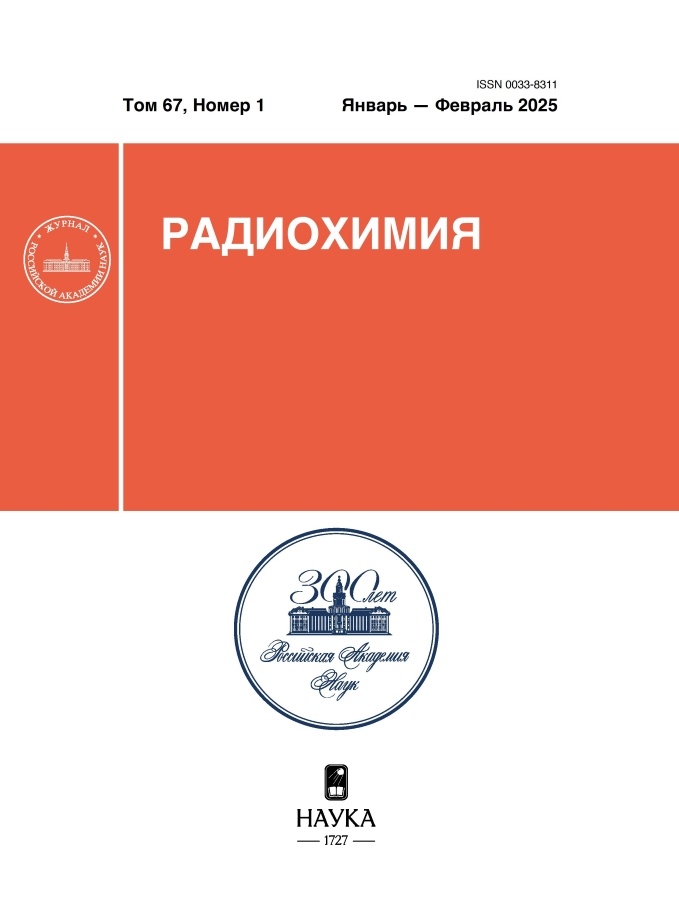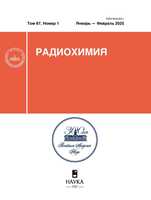Radiohimiâ
Radiochemistry is an international peer-reviewed journal that covers the theoretical and applied aspects of radiochemistry, including basic nuclear physical properties of radionuclides; chemistry of radioactive elements and their compounds; the occurrence and behavior of natural and artificial radionuclides in the environment; nuclear fuel cycle; radiochemical analysis methods and devices; production and isolation of radionuclides, synthesis of labeled compounds, new applications of radioactive tracers; radiochemical aspects of nuclear medicine; radiation chemistry and after-effects of nuclear transformations. The journal welcomes manuscripts from all countries.
Media registration certificate: № 0110195 от 04.02.1993
Current Issue
Vol 67, No 1 (2025)
Articles
Determination of conditions for the oxidation of UN and UC under microwave radiation
Abstract
The oxidation of UN and UC in a field of microwave radiation in air at atmospheric pressure has been studied. The influence of crucible material on the extent of oxidation of UN and UC was studied. It has been established that, under the influence of an MW field with a power of 800 W and a frequency of 2.45 GHz, under certain conditions, heating of UN and UC to ~993 K is observed with their oxidation in air to U3O8. For fast (15–20 min) and safe (without fires and explosions) oxidation of UN and UC, crucibles made of quartz and carbon ceramics are most suitable.
 3-9
3-9


Reaction of nitrate ion with formic acid in the presence of uranium
Abstract
The reaction of nitric acid with formic acid, including uranium-containing solutions, was studied. Empirical equations for the dependence of the induction period duration (τ) on the concentrations of reagents and temperature were determined. The dependence of τ on the concentration of formic acid is exponential. The effect of uranium concentration on τ in denitrated solutions becomes noticeable only at temperatures lower than 60°C. The main factor affecting the completeness of denitration is the molar ratio [formic acid] : [NO3]¯. Starting with the molar ratio of ≥3, uranium-containing solutions are denitrated at 90°C in an hour almost quantitatively. The resulting uranyl formate is partially precipitated. The initial stage of the reaction is accompanied by violent gas evolution. At 90°C, ~80% of the gas volume is released at this stage (about 10 s), whereas at 40°C, only ~10%.
The reaction of nitric acid with formic acid, including uranium-containing solutions, was studied. Empirical equations for the dependence of the induction period duration (τ) on the concentrations of reagents and temperature were determined. The dependence of τ on the concentration of formic acid is exponential. The effect of uranium concentration on τ in denitrated solutions becomes noticeable only at temperatures lower than 60°C. The main factor affecting the completeness of denitration is the molar ratio [formic acid] : [NO3]¯. Starting with the molar ratio of ≥3, uranium-containing solutions are denitrated at 90°C in an hour almost quantitatively. The resulting uranyl formate is partially precipitated. The initial stage of the reaction is accompanied by violent gas evolution. At 90°C, ~80% of the gas volume is released at this stage (about 10 s), whereas at 40°C, only ~10%.
 10-17
10-17


Kinetics of Tc(VII) reduction with diformylhydrazine in a nitric acid solution in the presence of U(VI) ions
Abstract
The Tc(VII) reduction with 1,2-diformylhydrazine in nitric acid solutions in the presence of U(VI) was studied spectrophotometrically. The reduction of Tc(VII) to Tc(IV) through the intermediate form of Tc(V) was found. The optical spectra were decomposed into two components by methods of mathematical processing. Kinetic curves have S-like appearance. It has been suggested that the induction period is associated with the Tc(V) formation. The kinetic equation of the Tc(IV) formation in the studied conditions was obtained. It was found that the rate of Tc(V) formation increases with an increase in the 1,2-diformylhydrazine, U(VI), and initial Tc(VII) concentrations and in the temperature but decreases with an increase in the nitric acid concentration. The reaction rate constants and partial orders of reaction components were found on the basis of the obtained data.
 18-28
18-28


Joint solubility of uranyl nitrate and plutonyl nitrate in nitric acid solutions
Abstract
The solubility of hexavalent plutonium and uranium nitrates in nitric acid solutions with the ratios in initial solutions Pu/(Pu + U) = 0.3 ± 0.015 (main data), Pu/(Pu + U) = 0.25 ± 0.025, and Pu/(Pu + U) = 0.5 ± 0.025 (single compositions) at +25, +15, and +5°C (±3) was determined by the method of isohydric crystallization. The calculated solubility isotherms of plutonyl and uranyl nitrates are presented in a wide range of nitric acid concentrations.
 29-34
29-34


Modeling of the composition of the gas phase over uranium–plutonium mononitride containing oxygen impurities and fission products
Abstract
The composition of the gas phase over uranium–plutonium nitride U0.8Pu0.2N0.99500.005 containing oxygen impurities and fission products after fast neutron irradiation to a burnup of 13.6% heavy atoms (h.a.) was subjected to a thermodynamic analysis in the temperature interval 900–2000 K. In this interval, the accumulation of fission products in the fuel leads to the formation of a multicomponent gas phase containing the following main elements and compounds: fuel (Pu, PuO, PuN, U, UO, UN), highly volatile (Cs, N2, Ba, Sr, CsI, BaI, SrI, I), volatile (Te, Pd, BaO, NdO, LaO, SrO, CeO), low-volatile metallic (Nd, Mo, Y, Tc, La, Ce, Zr), and low-volatile nitrides (NdN, LaN, CeN, YN, ZrN). The partial pressures of these components of the gas phase over U0.8Pu0.2N0.99500.005 at the 13.6% burnup as functions of temperature were calculated.
 35-41
35-41


Separation of actinides and REEs using TODGA in meta-nitrobenzotrifluoride: development and demonstration of flowsheet
Abstract
A process was developed for the extraction and separation of actinides and REEs from PUREX process raffinates using TODGA in meta-nitrobenzotrifluoride (F-3). The proposed flowsheet was tested under dynamic conditions using simulated raffinates of the PUREX process. The scheme includes joint extraction of actinides and REE, nitric acid stripping, actinide stripping, and REE stripping. The conditions of selective MA stripping by DTPA solution in the presence of a salting-out agent were determined.
 42-52
42-52


Separation of Am (V,VI) from Cm(III) and Pr(III) in ammonia and ammonium carbonate media
Abstract
New approaches to the selective isolation of Am from the actinide–lanthanide fraction of high-level wastes with preliminary oxidation of Am(III) to Am(V) and Am(VI) using ammonia and ammonia–carbonate media are proposed. It was found that, when ammonium hydroxide is added to a 0.1 M HNO3 solution containing Am(V), Cm(III) and Pr(III) (as a mimic of the behavior of lanthanides) to pH ~8, shows increased stability and is retained in solution up to 80%, and Cm(III) and Pr(III) in the form of poorly soluble compounds precipitate. It was also found that, in ammonia–carbonate solutions at pH ~10, up to 96% of the initial amount of Am(VI) is retained in the solution, and Cm(III) and Pr(III) precipitate to 85%.
 53-57
53-57


Effect of salting-out agents on the extraction of europium and americium from nitric acid solutions with 40% tributyl phosphate in a hydrocarbon diluent
Abstract
Experimental data on the extraction of nitric acid, europium, and americium with 40% TBP in C13 in the presence of salting-out agents such as sodium, magnesium, iron, and aluminum nitrates were obtained. The nitric acid and nitrate ion concentrations ensuring efficient recovery of transplutonium and rare earth elements were chosen. Based on the data obtained, corrections to the existing program for mathematical modeling (Statics, Dynamics program complexes) were made. To check the adequacy of program operation, computations were made for the experimentally tested flowsheet of the high-level raffinate partitioning using the extraction system based on TBP in paraffin in the presence of a salting-out agent. Comparison of the calculation results with the results of cell-by-cell analysis of samples from the first block shows that the deviations are within the measurement uncertainty of the analytical equipment. The possibility of predicting the operation of the extraction cascade at varied parameters (phase flow rates, number of steps, salting-out agent concentration) was demonstrated.
 58-64
58-64


Sorption purification of aqueous solutions to remove TBP using Stirosorb sorbent
Abstract
The sorption purification of aqueous solutions to remove TBP on the Stirosorb polymer sorbent in batch and column modes was studied. Sitorsorb polymer sorbent allows purification of aqueous media to remove TBP at a solution temperature not exceeding 70°C to an organic matter content of no more than 10–11 mg/dm3 at a load of ~0.9 g TBP/g sorbent. A solution containing U(VI) and Pu(IV) is purified to remove phosphorus-containing compounds on Stirosorb sorbent without solution depletion of U(VI) and Pu(IV).
 65-71
65-71


A study of cobalt speciation using a sorption method
Abstract
The effect of cobalt(II) speciation on the parameters of its interphase distribution was studied for different types of sorbents. Inorganic sorbents based on the hydrolyzable elements have shown the highest selectivity for Co in neutral and alkaline media (pH 7–10). The experiments on the cobalt sorption onto KU-2 strong acid cation-exchange resin at pH 3–5 have shown the presence of Co2+, which shows a high affinity for all the sorbents studied. In the neutral and low alkaline media, the inorganic sorbents adsorbed Со(ОН)+ and hydroxo complexes due to heterogeneous ion-exchange reaction (surface complex formation). The appearance of the S–pH dependences for the inorganic sorbents suggests higher stability of cobalt hydroxo complexes at microconcentrations as compared to the literature data. In the whole pH range studied, cobalt(II) showed a behavior of an inert sorbate with all the inorganic sorbents studied.
 72-80
72-80


The influence of uranyl nitrate on exothermic processes in nitric acid solutions of reducing agents
Abstract
The thermal stability of nitric acid solutions of acetohydroxamic acid, carbohydrazide, hydrazine nitrate, and their mixtures was studied. The onset temperature of the exothermic reaction was determined, and the thermal effects of the reactions were calculated. The influence of uranyl nitrate on the thermal stability of reducing agents and their mixtures was studied. Comparison of the characteristics of exothermic processes in solutions with and without uranyl nitrate showed that the introduction of uranyl nitrate reduced the intensity of exothermic processes in all the nitric acid solutions studied.
 81-87
81-87


Effect of temperature during preactivation of 5% Pd/C and 5% Pd/Al2O3 with deuterium gas on isotope exchange between deuterium water and an organic compound
Abstract
It was demonstrated by the example of serotonin, 3-(N-pyrrolyl)propanoyl-L-histidine, sodium p-phenylbenzoate, and Pro–Gly–Pro that activation of isotope exchange with D2O also occurred when a solution of an organic compound in D2O was mixed with 5% Pd/Al2O3 or 5% Pd/С (after preliminary treatment of catalysts with deuterium gas on heating). When implementing this technique, 2–3 atoms of deuterium were incorporated in serotonin, 4–5 atoms, in Pro–Gly–Pro, 7–8 atoms, in 3-(N-pyrrolyl)propanoyl-L-histidine, and 3–4 atoms, in sodium p-phenylbenzoate. In the latter case, as judged from the composition of the reaction products, atomic deuterium takes part in the activation of isotope exchange with D2O. The participation of atomic deuterium in these reactions follows from the intensification of the degradation of the compounds during deuteration. When using compounds that do not contain labile fragments, isotope exchange with D2O can be activated by keeping the catalyst at room temperature and heating.
 88-100
88-100













